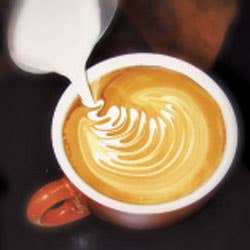
Crema of the Crop
This is Part V of a series on Specialty Coffee, presented by the Specialty Coffee Association of America in conjunction with Saveur.com.
Part I: The Road to Perfection
Part II: The New Frontier of Quality Coffee
Part III: Artisanal Roasting 101
Part IV: How Do You Brew?
Part VI: Nothing Regular About It
What is a barista? The word comes from Italy (where it means bartender), but here in the United States the term barista first appeared in the Italian cafes of North Beach in San Francisco during the turbulent but defining mid-1970s.
There the Old World-influenced coffeehouse made a transition into something uniquely American, a Bohemian fusion where writers, poets, lawyers, and laureates read James Joyce aloud on writers' night and live jazz blended with the sounds of beans being ground and milk being steamed. The genius behind this social phenomenon? The barista.
Go into a cafe, restaurant, or bakery, and order an espresso. You are served something fresh, prepared immediately, and served only to you. Espresso is special. Espresso is intense. Espresso is the pure expression of the soul of coffee.
Technically, espresso is finely ground coffee (approximately seven grams) firmly packed into a small filter and inserted into an espresso machine. It is brewed inside the little filter at a high temperature and under high pressure for a very short time (approximately 23 seconds). The beverage that is produced is espresso. It should reach the cup with the consistency of warm honey—a one-ounce shot of pure coffee essence. During the espresso brewing process, emulsified oils condense and create "crema," the golden-amber or reddish foam that floats on top of the espresso. Crema is like liquid velvet as it clings to a demitasse spoon. It is the face of espresso and the sweetest, most joyful part. Delicious crema is the first sign of a quality espresso. The Italians have presented many fine gifts to the world, but few are as wonderful as espresso. Mille grazie.
People come together over espresso. Espresso is an aromatic magnet that binds them with the promise of delighting the senses and invigorating the mind. Espresso brewing is science and art. The barista is a chef of coffee and a performance artist. Like a sushi chef, a barista entertains while producing a professional result with swift and practiced movements.
You are the judge of your local barista. An excellent espresso should have soul-satisfying body, a smooth texture, a rich sweetness, and a pleasant taste on the palate that lingers for at least an hour. Never bitter, never insipid, never acrid! Espresso, prepared well, will offer complexity in the cup and a balance between flavors and body. Does it sound as if we were tasting wine? Tasting an amazing espresso is much like tasting wine. You have to practice in order to teach your palate. As with wine, that is a seriously fun task. With practice you will notice spice, nuts, cedar, caramel, chocolate, citrus, and many other flavors. You will also find uncomfortable and unpleasant flavors that you should avoid. Soon you will be able to choose your coffee like a true aficionado.
Keep Reading
Continue to Next Story










